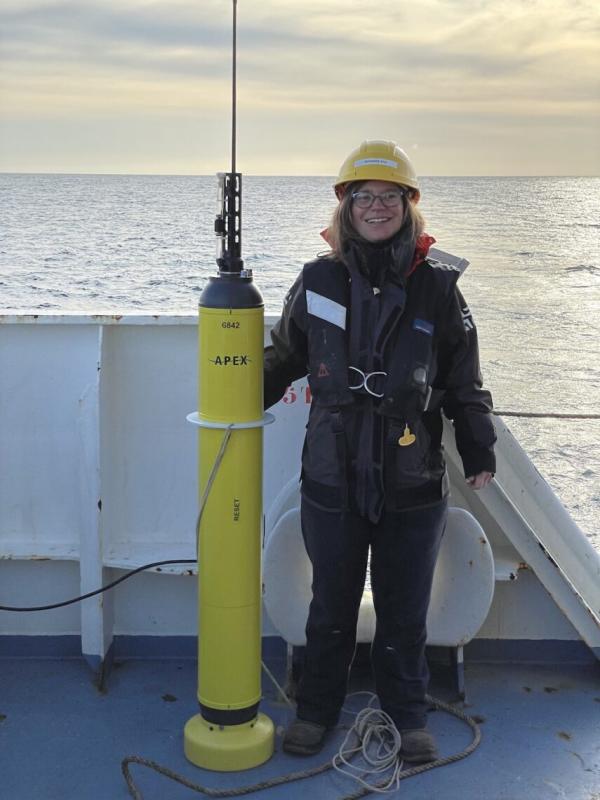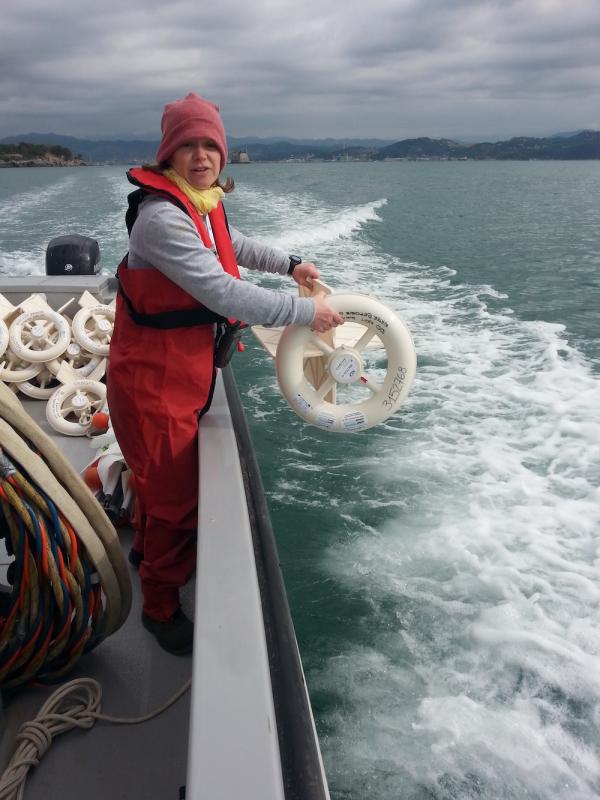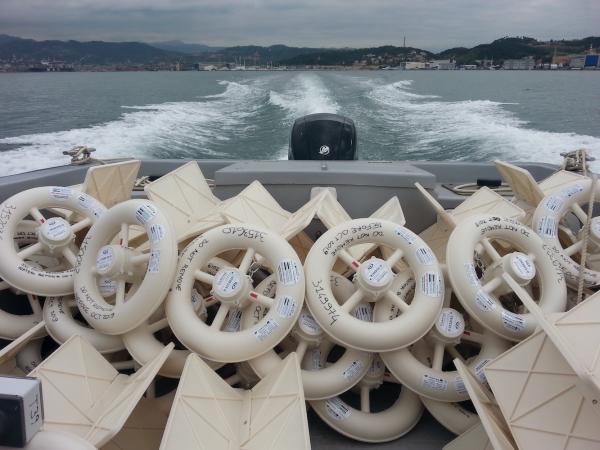The Langrangian experiments
Maristella Berta is in charge of coordinating the Lagrangian instruments for the BioSWOT-Med campaign. She describes what drifters and floats are, the information they can collect and how real-time data can contribute to BioSWOT-Med's adaptive sampling strategy.
Maristella Berta and a float.
RESEARCH TOPICS - Maristella Berta is a researcher in physical oceanography at the Institute of Marine Sciences - National Research Council (CNR-ISMAR) in Lerici, La Spezia, Italy. As part of the BioSWOT-Med campaign, she is in charge of coordinating the Lagrangian instruments. She describes what drifters and floats are and the information they can collect.
What are your research interests outside BioSWOT-Med?
I am a physical oceanographer focusing on the dynamics of ocean currents by analysing observations from field sampling (buoys and sensors at sea), remote platforms (such as satellites and radars) and ocean model outputs. I am interested in the combination of independent and complementary observation platforms, which is essential for obtaining a global picture of oceanic processes taking place at different scales at the same time. Multidisciplinarity is also a key aspect of the multi-platform approach, as it enables us to study the interaction between the physical and biogeochemical components of the ocean. Among the physical processes that characterise the upper layer of the ocean, I study the way in which marine currents lead to the dispersion of tracers and passive particles (such as pollutants like oil or plastic, and biological tracers like microalgae or fish larvae), and the transport of these particles vertically (from the surface to the depth, and vice versa). Understanding these processes can provide insights for practical applications such as marine accident response or the management of marine protected areas.
As part of the BioSWOT-Med campaign, you are in charge of coordinating the Lagrangian instruments. What does lagrangian mean?
Lagrangian instruments are devices that measure the properties of seawater in response to ocean currents. This category of instruments differs from Eulerian instruments, which observe the properties of seawater from a fixed point, such as a device moored to the seabed. Lagrangian instruments must be equipped with a GPS (Global Position System) plotter and a satellite communication system so that measurements and the corresponding position can be retrieved at regular intervals.
Drifters are Lagrangian buoys generally fitted with drogues that make them 'sail' at a specific depth: CODE and CARTHE dinghies follow surface currents in the first metre, while the SVP design includes a drogue centred at 15 m depth to be representative of the dynamics of this layer of water. Other dinghies, such as spotters, are designed to float at the air-sea interface and have no drogue.
The floating instruments, on the other hand, are pseudo-Lagrangian in the sense that they are not totally passive to marine currents, since they drift at a specific depth and periodically perform vertical cycles measuring the properties of the water from depth to the surface, where they also transmit their position and the data they have just recorded. As part of BioSWOT-Med, we will have 30 CARTHE plus CODE, 20 SVP, 2 spotters and 6 floats.
What types of sensors are fitted to dinghies and floats, and how do you use the information gathered by these instruments?
In addition to the basic configuration of the drifting buoys (simply the GPS tracker, as in CODE and CARTHE), the other types of drifting buoys involved in the experiment are equipped with additional sensors to measure essential ocean variables such as seawater temperature (for SVP), waves (for Observers) or the biogeochemical properties of the water (in the SVP-BGC prototype). All the floats (six) are equipped with pressure, temperature and conductivity (for salinity) sensors, four of them have an additional oxygen sensor, while the other two also have biogeochemical sensors.
In Lagrangian data sets, we examine the individual trajectories of floats, but more importantly the relative displacement of floats within a group. This analysis can indicate converging or diverging water masses in the upper layer of the sea, where strong vertical currents tend to develop and, in turn, enhance the exchange of water properties between surface and depth. Combining drifter trajectories with water column sampling from floats can help characterise sea properties in correspondence with points of intense water mixing, which may be associated with high biological productivity.
On board, you will be analysing the data collected by the Langrangian instrument in real time. How will this contribute to the campaign's sampling strategy?
During BioSWOT-Med, we will target specific features of the small-scale circulation (of the order of 10 km), such as eddies or fronts (the interface between two different water masses) identified in SWOT satellite swaths. Satellite observations will guide the choice of the field of activity that we will begin to explore with water sampling and the deployment of drifting buoys. Thanks to initial real-time processing, the Lagrangian component (drifters) will help to assess and refine the target identified by the SWOT images and provide guidance for the deployment of other instruments at sea capable of resolving smaller-scale processes. In a second phase, analysis of drifter data can be used to quantify surface divergence and convergence and to provide an estimate of the magnitude of vertical currents in the target area. Analysis of the floats and other high-resolution observations will help to characterise the variability of biophysical properties in the target zone.
Contact us: Tosca Ballerini
More information
Maristella Berta deploying a float CARTHE
CARTHE floats







